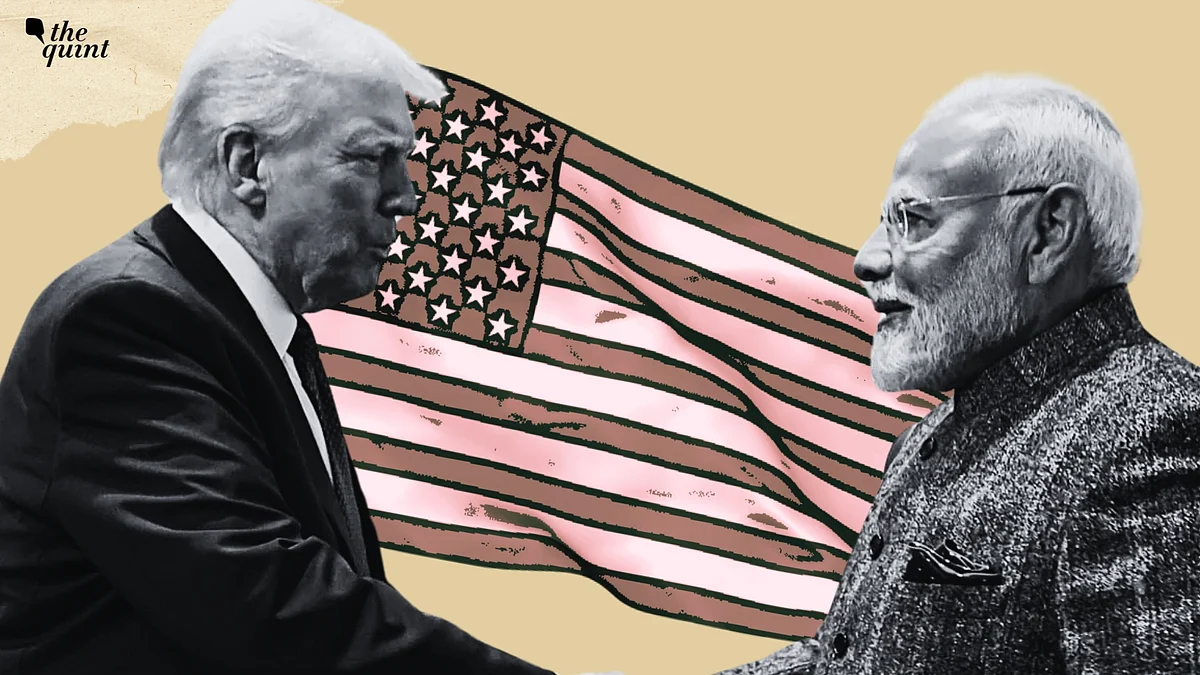
Dear India, Negotiate the Insane Trump Tariffs at Your Own Peril
Instead of slashing the tariffs for the US alone, India should reduce them universally, writes Subhash Chandra Garg.

advertisement
After falsely claiming that more than 75 countries were eager to negotiate, Donald Trump paused his irrational reciprocal tariffs for 90 days. (Reciprocal tariffs are the US President's clever attempt to disguise 50 percent of the US trade deficit-to-imports ratio as tariffs.) Some outrageous tariffs remained in place: 134 percent on China (rendering trade virtually impossible at such rates), 10 percent on all countries, and 25 percent on steel and aluminum.
Facing the adverse effects on domestic services, consumption, and a looming risk of recession and inflation, Trump has begun rolling back. Just two days back, on 12 April, he cancelled new tariffs (including those on China) on smartphones, laptops, and various electronic goods. Further rollbacks are likely in the coming days and weeks.
The White House spokesperson admitted that only 15 countries have submitted proposals to negotiate, which are reportedly under review. No negotiations have commenced yet. It remains unclear whether India is among these 15 countries.
So, the big questions are—should India negotiate with Trump? Should it be an early mover or wait and observe others? Should it grant concessions solely to the US?
FTA With the US of A
The India-US Joint Statement dated 13 February 2025, signed during Prime Minister Narendra Modi’s visit to the US, declared a bold vision: Mission 500, aiming to more than double bilateral trade to $500 billion by 2030, referring to total merchandise and services trade.
The statement also mentioned that both leaders are committed to negotiating the first tranche of a mutually beneficial, multi-sector Bilateral Trade Agreement (BTA) by Fall 2025.
Commerce Minister Piyush Goyal has rightly found the situation unnerving, stating: “We don’t negotiate at gunpoint.” He’s clear, like others, in prioritising India’s interests. Yet, a senior official still believes the BTA could take a “win-win shape and form.”
No way. Negotiations, if and when undertaken with Trump, will leave India bloodied.
Trump’s Demands Are Unrealistic
The US Trade Representative’s Report (USTR) on Foreign Trade Barriers (FTBs), released in March 2025, outlines what Trump is likely to demand: reduced tariffs, elimination of non-tariff barriers, and increased American exports.
The report notes India’s average Most Favoured Nation (MFN)-applied tariff rate was 19 percent in 2023 – the highest among major economies – with an alarming 39 percent for agricultural goods. It highlights steep tariffs on products the US wants to export:
Soybean oil (45 percent)
Apples, corn, motorcycles (50 percent)
Automobiles (60 percent)
Raisins and walnuts (100 percent)
Alcoholic beverages (150 percent)
Trump will push India to drastically slash these tariffs. Can India realistically match the US' 0-5 percent tariff levels?
Additionally, it flags technical barriers: quality control orders on chemicals, mandatory domestic testing, sanitary and phytosanitary norms, GMO-free certifications, dairy product requirements, poultry prohibitions, and more.
Government procurement policies – like the Department for Promotion of Industry and Internal Trade’s 2020 Public Procurement Order favouring domestic content – are under fire too, along with concerns over intellectual property protection, data flow restrictions, electronic payments, legal services, telecom, e-commerce barriers, and agricultural subsidies (e.g., MSP and public stockholding).
Deal with Trump, Only at Our Peril
The Trump administration is also expected to insist India buy more American oil, gas, military equipment, and other goods. India seems amenable in parts, but US oil and gas are costlier due to transportation. Purchasing aircraft and military hardware through bilateral deals may invite allegations of corruption or jeopardise national security.
Can Indian negotiators ramp up US imports in this frenzied environment?
Meeting US demands on tariffs and non-tariff barriers is near-impossible. Conceding anything exclusively to the US would prompt similar demands from other major partners — like the European Union (EU) and the UK.
If India negotiates early and ends up with a deal worse than what others (China, the EU, and Vietnam) secure, it will be politically indefensible. Negotiating now could be a trap. India must tread with extreme caution.
What Should India Do Instead?
India faces two key consequences of Trump’s tariff chaos:
A short-term global surplus created by the drop in US imports
An urgent need to reform its outdated trade regime
US-China merchandise trade is valued at $600 billion annually, with Chinese exports to the US at $450 billion. Assuming this insanity lasts three months, China may face a surplus of $110 billion in April-June (slightly lower post the electronics rollback). Other nations will also see surplus stock.
India’s trade regime, shaped in a 20th-century world, needs urgent reform. High tariffs on agriculture and automobiles serve little purpose now. Instead of slashing them for the US alone, India should reduce them universally—in exchange for services and workforce mobility access.
Non-tariff barriers must be thoroughly reviewed to ensure India’s industries compete globally. India must also learn to do business with China. It would be a true win-win if Chinese companies manufactured in India for global exports.
This crisis can be India’s big opportunity—if we play it right.
(Subhash Chandra Garg is the Chief Policy Advisor, SUBHANJALI, and Former Finance and Economic Affairs Secretary, Government of India. He's the author of many books, including 'The $10 Trillion Dream Dented, 'We Also Make Policy', and 'Explanation and Commentary on Budget 2025-26'. This is an opinion piece, and the views expressed above are the author’s own. The Quint neither endorses nor is responsible for the same.)
- Access to all paywalled content on site
- Ad-free experience across The Quint
- Early previews of our Special Projects
Published: undefined